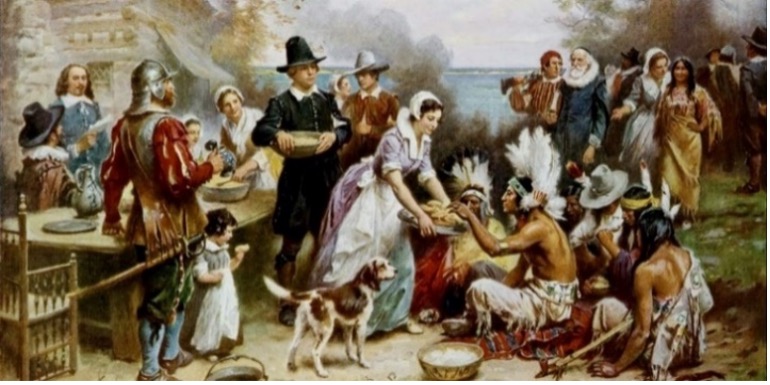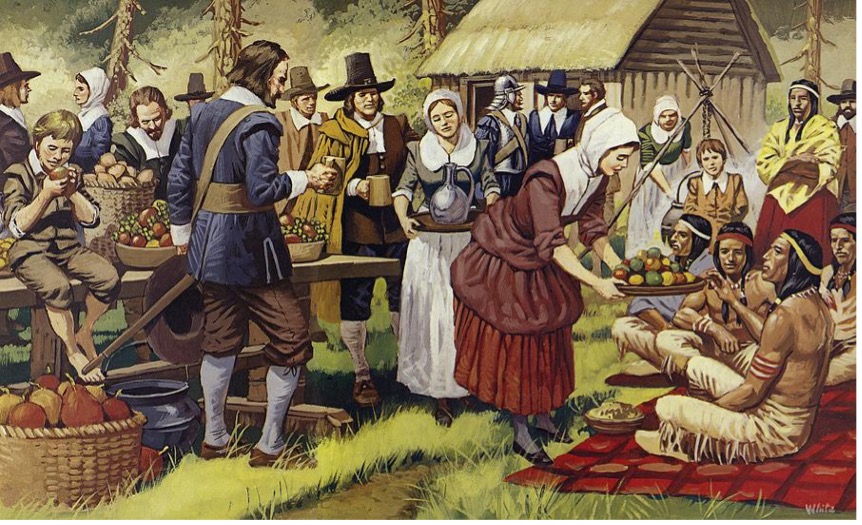Tuesday, November 16, 2021
 UNT System HR brings you UNT World experts with this periodic and always timely installation
called "Ask An Expert." So, let's ask...
UNT System HR brings you UNT World experts with this periodic and always timely installation
called "Ask An Expert." So, let's ask...
EXPERT: Guy Chet, Ph.D., UNT history professor, is an early modern historian (17th-18th century), teaching classes on Revolutionary America, Atlantic piracy and military history. He's the perfect expert to explore the history of Thanksgiving, from the First Thanksgiving's realities and falsehoods in 1621 to our modern-day celebration. He takes us into the amicable relationship between the Pilgrims and Native Americans at the first feast, and the complications that followed; and then examines the events in America and Americans' psyche during pivotal moments in history when President Lincoln declared Thanksgiving an official holiday some 240 years after the First Thanksgiving during the Civil War, followed nearly 80 years later when President Roosevelt made it a Federal holiday to be celebrated on the final Thursday of November at the onset of World War II. Please, dig in.
Q: The story of the First Thanksgiving (1621) is usually told as a story of a neighborly gathering between the Pilgrims and Native Americans. However, this version is particularly fraught with falsehoods about the times and the relations of these two groups. What do the facts reveal about that initial Thanksgiving?
Dr. Chet: Historically, Thanksgiving is a harvest holiday that was observed in England and
in the Germanic parts of Europe. In England, they observed days of fasting when God
inflicted bad things on them, such as floods and droughts, and they celebrated days
of thanksgiving when God showed His benevolence – a victory on the battlefield, good
harvests, etc. In 1606, for example, the English started celebrating an annual day
of thanksgiving on Nov. 5 to commemorate the thwarting of the “gunpowder plot” to
blow up King James I and his Parliament. This holiday eventually became Guy Fawkes
Day, which is still celebrated there today.

The traditional tale about Thanksgiving in America indeed retells the story of the thanksgiving celebration that took place in 1621, a year after the settlers arrived at the colony of Plymouth. They had a feast with the neighboring Algonquin Indians, which demonstrated their bond of friendship and neighborliness, facilitated trade between them and cemented their military alliance.
Those who debunk and ridicule this story point out that it’s a fairy tale that we tell children about how sweet, tolerant and benign our ancestors were, when in fact, in the years that followed, these English settlers took advantage of their Indian neighbors in trade, fought wars against them and pushed them off their land.
This is true, of course, but it does not negate the fact that in 1621, these groups really did have good relations – they were commercial trading partners, and they were military allies against the traditional Indian enemies of the Algonquin Indians. Over the next 50 years, however, relations grew worse. It’s a common story in human history – friendly relations go sour (see, for example, the United States and Cuba or Iran). By the same token, history is filled with stories of former enemies becoming friendly over time – the United States and Canada, Britain and France, Germany and Russia, Israel and Egypt...
When people debunk the story of the First Thanksgiving, therefore, they don’t really debunk it. They instead contextualize it by pointing out that it was merely the first scene in a long play, and that the following scenes in the drama of Anglo-Indian relations were decidedly less friendly and benign. By contrast, the traditional story of the First Thanksgiving tells the story in context of the previous year.
The English settlers in Plymouth lived through a harrowing and miserable experience that first year (1620-21) – their crops failed, they didn’t know how to hunt or fish, and the New England winter was much harsher than anything they had experienced in England. They were starving and helpless – of the 102 settlers that landed in Plymouth, 45 had died that first winter from starvation or disease. Considering the First Thanksgiving in this context (the context of the previous year, rather than of the years that followed) sheds light on the mentality of those settlers, whom we (modern Americans) usually struggle to understand.
Most of us would not have it in us to thank God after experiencing such hardships and seeing our friends and family starve to death; we would instead be resentful or angry. When the story of that original Thanksgiving feast is told in context of that cruel first year, it directs people’s attention to the contrast between those settlers and us; it makes us consider what makes some people respond to misfortune with resentment and others with gratitude.
Resentment and gratitude reflect one’s preexisting expectations. People who expect a great deal – from society, from the world or from God – are only mildly grateful when they receive what they are owed, but are greatly disappointed (even resentful) when life fails to live up to those expectations. By contrast, people who expect little will be only mildly disappointed in the face of misfortune. The settlers’ expression of gratitude in 1621 indicates to modern audiences that they believed God (or the world) did not owe them a thing; they deserved nothing. Everything they did have was therefore a gift. So they could look at everything and everyone they had lost and still express sincere gratitude for what they had been given.
I once read a funny journal entry by one of the settlers telling about their troubles, their losses, the hunger and the bitter cold. But the diarist pointed out that there was reason to believe that God was smiling on their endeavors, because after two months of failure at fishing, they had their first success when they found a dead carp that had washed up on the shore.
Those who frame the story of the First Thanksgiving in context of Anglo-Indian hostilities
in the years that followed are interested in interracial relations in America and
in the fate of this continent’s original inhabitants. By contrast, those who frame
the story in context of the preceding year are interested in the settlers themselves.
Americans who cherish the traditional story of the First Thanksgiving do so not because
they think colonial America was an interracial paradise, with Anglo-Americans and
Native Americans living in peace and harmony. Rather, they cherish it because they
admire the mentality they see on display during that first harvest feast and wish
to emulate it – to not be complainers who think the world owes them stuff; to not
focus on what they don’t have; and to appreciate and be grateful for everything they
do have, which is a lot.
Portrait of a scene from the first Thanksgiving in 1621
Q: A Thanksgiving holiday had been celebrated in England and later in different portions of North America at different times correlating with the harvest. It is interesting that it wasn’t until 1863 that President Lincoln declared Thanksgiving an official holiday during one of the most difficult and divisive periods in American history, the Civil War; and it wasn’t until December 26, 1941, that President Roosevelt signed the law establishing the fourth Thursday in November as a Federal Thanksgiving holiday, again during a time of war, soon after the U.S. officially entered World War II. Is there any correlation between the war-time timing of these two recognitions of Thanksgiving?
Dr. Chet: It is tempting to see the timing of these national measures – in the midst of a national military crisis – as significant. In 1863, military victory for Union forces was very much in doubt. Also in doubt was Lincoln’s reelection in the 1864 presidential election, which threatened to bring to power a Democratic administration that would end the war by recognizing the Confederate States of America.

In December 1941, the United States suffered a stunning and devastating Japanese attack, which launched the country headlong into a massive global war that most Americans had hoped to sit out. Millions of young men were about to be drafted into the armed forces and sent to foreign battlefields, and millions of families faced challenges and dangers on the home front.
The United States has always been a deeply religious nation, so in the context of such grave threats to the nation and to millions of Americans, one can imagine the U.S. government establishing a national holiday of thanksgiving to reaffirm the nation’s relationship with God and draw strength and faith from that affirmation. This is a common religious experience in moments of existential crisis – a person realizes that s/he is at a moment of great import; a moment of accounting that clarifies his/her connection to and dependence on God. Psalm 23 (one of the most popular and best-known portions of the Bible) dramatizes this religious experience vividly. Until the moment of existential crisis, the Psalmist speaks of God in the third person: "The Lord is my shepherd; I shall not want. He maketh me to lie down in green pastures: he leadeth me beside the still waters. He restoreth my soul: he leadeth me in the paths of righteousness for his name's sake." But, once he faces mortal danger, as he walks "through the valley of the shadow of death," the author speaks to God directly, in the second person, "for thou art with me; thy rod and thy staff they comfort me. Thou preparest a table before me in the presence of mine enemies: thou anointest my head with oil; my cup runneth over."
However, this spiritual explanation for the establishment of Thanksgiving as a national holiday doesn’t match the timeline in both the 19th and 20th centuries. President Lincoln indeed issued a proclamation in 1863 inviting all Americans to observe Thanksgiving on the same day, and he indeed connected the holiday to the challenges and hardships of the war, but efforts to nationalize the holiday had been ongoing since the 1840s. This effort should thus be seen not as a reflection of wartime anxiety, but of the ongoing consolidation of the United States in the 19th century. From a patchwork of local communities and economies, the country was slowly connecting and drawing together into a more unitary whole – economically, logistically, culturally, legally and politically. It was this consolidation, indeed, that transformed slavery from a purely local arrangement into a national issue that demanded a national policy (first the Missouri Compromise, then the Compromise of 1850, then the Dred Scott decision, then emancipation). This growing national integration produced a growing desire in the country to experience Thanksgiving together, as a nation; to transform it from a holiday celebrated at different times in different parts of the country into a unitary national holiday, celebrated at the same time from coast to coast. Congress enacted a law to this effect in 1870. Following Lincoln’s lead, the holiday was celebrated on the last Thursday in November, but this date was not stipulated in law.
As for FDR, in December 1941 he signed into law a joint resolution of Congress that specified the last Thursday in November as Thanksgiving Day, but Congress had introduced that resolution already in January of 1941, and approved it in October, two months before the Japanese attack on Pearl Harbor and America’s consequent declaration of war. Congress passed this resolution in 1941 because in 1939 and 1940, President Roosevelt moved the holiday from its habitual date to the third Thursday in November to extend the Christmas shopping season in yet another flailing attempt to stimulate the economy during the ongoing Great Depression. FDR’s signing of the Thanksgiving law should be attributed not to the wartime mood that descended on the nation in 1941, but to Americans’ attachment to this holiday. The president’s unilateral tinkering with the holiday schedule irked Americans, so they mobilized their congressmen to force the president to stop.